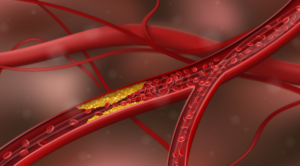 >In our quest at Biohackr Health to increase healthspan and longevity, one of the only areas where you can truly affect change (and perhaps reversal of risk) is by lowering your risk of heart disease.
>In our quest at Biohackr Health to increase healthspan and longevity, one of the only areas where you can truly affect change (and perhaps reversal of risk) is by lowering your risk of heart disease.
We talk about atherosclerosis. This is a fancy term to indicate the buildup of plaque and the hardening of your arteries, which affect every system in your body. Think of your arterial system as a sprinkler system for your body. You need to get water for your plants so they thrive. Atherosclerosis is clogging your hoses, therefore every system in the body suffers. You may be aware of its effects on your risk for heart attack, stroke, and blood pressure issues, but it also affects blood flow to your genitalia (impotence), legs (claudication and pain with walking), kidney blood supply, and hair growth.
This is not new information. In medical school, we learn about the main players in atherosclerosis: diabetes, smoking, cholesterol, and high blood pressure. For cholesterol, the main focus has been on LDL and HDL. LDL is known as the “bad” cholesterol, and you ideally want your number to be under 100. HDL is the “good” cholesterol, and you want the ratio of these to be good. However, more recent studies are drilling down on other types of cholesterol, as the idea is they may be BETTER markers for atherosclerotic risk.
So what is ApoB?
Apolipoprotein B is a protein that helps carry fat and cholesterol in your body. Fat and cholesterol don’t dissolve in your blood, so to carry these compounds, they are packaged with apoliproteins. ApoB carries a lot of the “bad cholesterol” – VLDL, LDL, and IDL. It then attaches to receptors on your cells, which allows the cholesterol into the cell where it’s broken down and releases cholesterol into your blood. It is this release which leads to atherosclerosis.
There are two variants of ApoB — one that is made in your gut and one in your liver. The blood test looks for ApoB 100, which is the variant in your liver. Many think this is a more accurate risk assessment of cardiovascular risk than LDL.
What is a good number?
You want your level to be below 100. An ideal level is 30-40. (“Normal” is up to 130 in men, 117 in women.)
How can you lower it?
Exercise does little to change your ApoB. Dieting does a little to help lower your ApoB if you avoid carbohydrates and saturated fats. This is an area where medication really makes the difference. This is through two main ways: statins and PSCK9 Inhibitors.
How can Biohackr Health help?
- TESTING: We do a comprehensive cholesterol panel, which includes HDL, LDL, Apo A, Apo B, and homocysteine.
- THE GOAL is to achieve an ApoB lower than 60. Ideally, the level is likely around 30.
- HORMONES: Turns out estrogen helps with ApoB levels. If you are peri/post-menopausal, know your hormone status.
- REFERRAL FOR CARDIAC CALCIUM SCAN: Do you have exiting plaques? This CT scan will help you evaluate. It’s part of our Biohackr Benchmark Program.
- REFERRAL FOR MEDICATIONS: We do not prescribe statins here, but we will advise you on current up-to-date recommendations. Many doctors will state “your levels are normal.” However, this is reactionary — if you are at a higher risk of cardiovascular disease, you want to OPTIMIZE and try to reverse buildup if you can. This is one area in biohacking where there is testing, true scientific understanding, and established ways to improve your cholesterol levels which are shown to help lower your risk.
- STATINS & PSCK9: Rosuvastatin (Crestor) or Pravastatin (Pravachol) is first line. The PSCK9 inhibitors are not covered by most insurances yet (Praluent, Repatha). PSCK9 is focused on the liver removing more LDL.